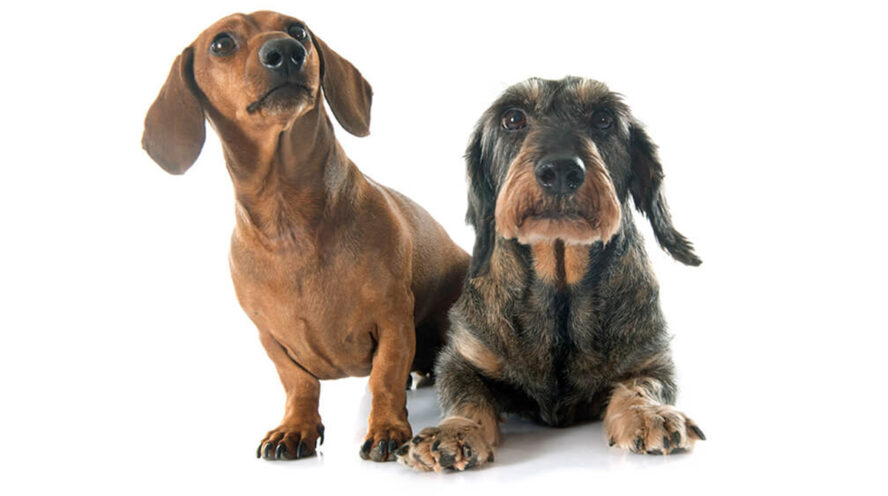What comes to your mind when you think of a dachshund? You probably visualise your neighbour’s little cutie, – a short-haired dachshund with black or chocolate coat. An interesting and surprising fact though, is that dachshunds are the dog breed with the most diversity in terms of the colour and fur type varieties!
Not to mention that some of dachshund
Let’s dive into the world of one of the most popular dog breeds in the world, and take a closer look into dachshund
Dachshund Physical Characteristics
Dachshunds – these smart and small hound dogs have long bodies, short legs, and powerful muscles. According to history, we have come to know that they were once-upon-a-time hunting dogs. Therefore, they successfully flesh out badgers, rodents, rabbits and other burrowing animals.
The Kennel Club usually defines physical characteristics of the breed. Until now, they serve as a guideline which describes the ideal appearance and features of the breed.
General physical characteristics of a dachshund breed:
- Elongated body; the muscles are well defined, the rib cage bulges out, breast bone is very prominent. Rib cage smoothly merges into the abdomen. The back is straight, horizontal, without sagging.
- Elongated head, resembles the shape of a cone, with strong jaws. Strong jaw bones, with powerful teeth and large canines. Teeth should not be visible, and all of the teeth should be present. Tremendous power of bite and hold.
- Medium size, almond-shaped eyes. Mostly dark color, lighter color in Chocolates, in Dapples one or both eyes can be blue.
- Ears set high, in the form of a triangle, very mobile, well-rounded ends touching the cheeks. Not narrow, pointed or folded.
- Front feet are larger and slightly turned out. Back feet are smaller and straight.
- Height at the withers should be half the length of the body.
It is important to remember, that dachshunds, not meeting these criteria’s, cannot be officially registered for breeding.
Dachshund colours

Maybe I will surprise you by saying that sausage dogs come in huge array colours, with more than 20
As it comes to the dachshund
To begin with, there are basic dachshund colours, – black, blue, cream, tan, red or fawn (Isabella).
Blue and fawn (Isabella)
After all, d
In real life though, Dachshunds rarely come in one solid colour, but more in colour combinations. As can be seen, they include black and tan, black and cream, blue and tan, fawn and tan, chocolate and tan, chocolate and cream.
There is also a wheaten dachshund
The best way to help your dachshund live longer?
Watch our video to find out!
Dachshund colours: Coat patterns
Apart from the usual dachshund colour combinations, wiener dogs come in a few interesting colour patterns. The important thing to remember is that colour pattern can affect any of the dachshund’s base coat colour.
Dapple
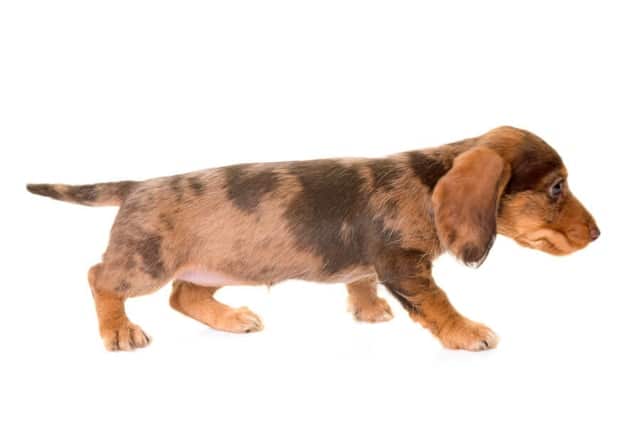
Dapple is a pattern, caused by a particular gene diluting the coat colour.
The dapple
Some dapple pattern can be very bright and visible, whereas in specific
Dapple is a dominant gene; therefore to produce a dapple puppy one parent must be a dapple. Therefore, two parents with non-pattern coats cannot produce a dapple puppy.
If you want to find out more, you will find a separate article about Dapple Dachshunds by clicking the link.
Double Dapple
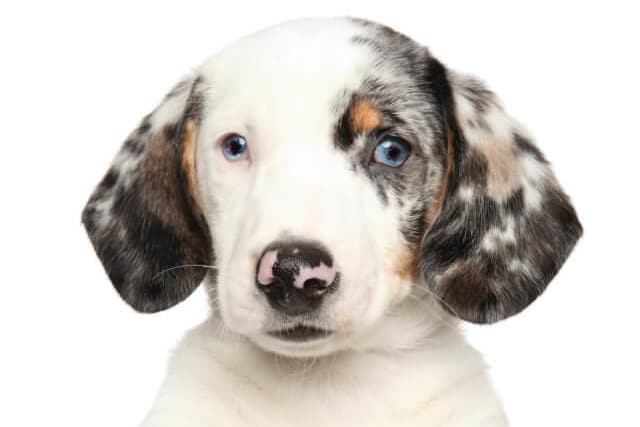
In the event that two dapple dachshunds are bred with each other, they can produce a double dapple dachshund puppy. Each puppy in a double dappled litter has a 25% chance of having the dominant dapple gene activated. This,
A double dapple dachshund puppy will always have white markings and often will have blue eyes, but may also have one dark and one blue, or both dark eyes.
It is important to know that breeding of double dapple dachshunds has been determined to be ‘unacceptable’ by many Kennel clubs. This is because double dappling is associated with many inherited health issues in double dapple dogs.
Apparently, dapples should be bred with caution in red and cream coloured dachshunds. A red and cream dapple is very problematic to distinguish from a shaded red and cream solid
If you want to find out more, you will find a separate article about Double Dapple Dachshunds by clicking the link.
Piebald
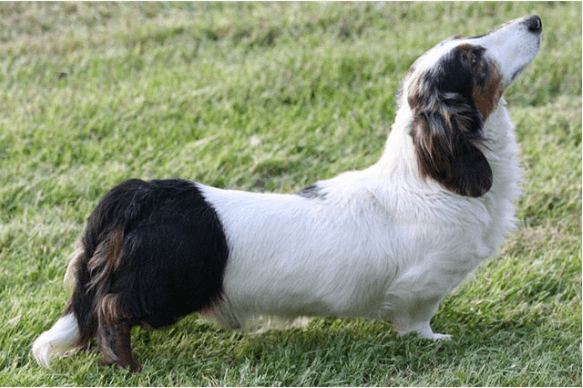
Commonly, the piebald pattern is described as areas of solid
Additionally, piebald dachshunds can have ticking (small spots of colourover the white background). Ticking is also acceptable.
Piebald puppies can only be bred when both parents are piebald or carry the piebald gene.
People often confuse the piebald pattern with double dapple pattern in dachshunds, but these are two different types of coat pattern.
Firstly, there is one way to distinguish them,- piebalds are born only with brown eyes. On the other side, double dapples can have blue eyes, or one blue and one brown eye.
Secondly, piebalds will always be solid-colored dachshunds without shading; although they can have a solid white base or have
If you want to find out more, you will find a separate article about Piebald Dachshunds by clicking the link.
Brindle
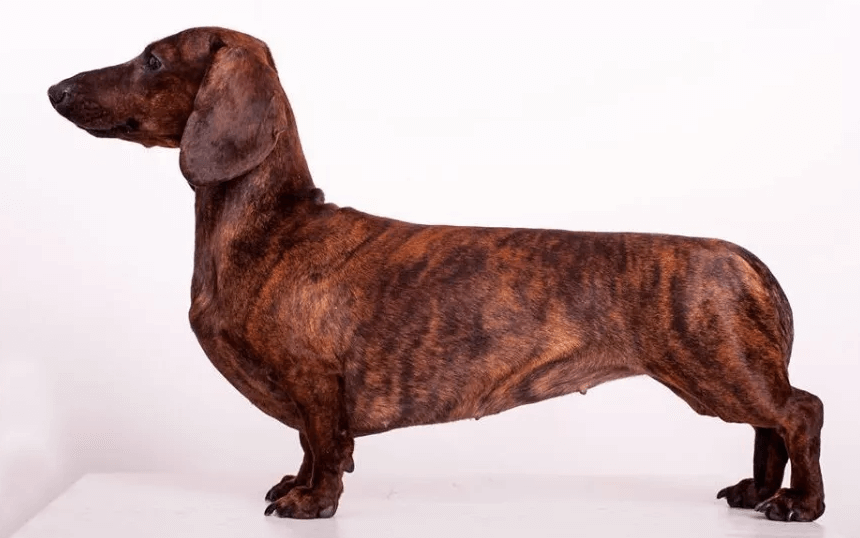
This unusual pattern consists of splotches or stripes of one colour over a solid base coat. Commonly, brindle dachshund will have stripes all over the coat, in a tiger-like pattern.
First of all, the base
Also, in longhaired and wire-haired dachshunds the fur can obscure brindle pattern by making the stripes less distinct.
Namely, brindle is caused by a dominant gene, which means that one parent should be brindle to produce a brindle puppy.
However, unlike with Dapples, there are no health issues with puppies, produced with both brindle parents.
If you want to find out more, you will find a separate article about Brindle Dachshunds by clicking the link.
Sable

Generally, all the hair of the sable dachshund (except for face and feet) will be banded at the base with red and black at the tip. On the contrary, the face and feet will be usually of the main dachshund
Apparently,
As a general rule, a true sable pattern will look darker, more like black and tan from a distance. Ultimately, at least one of the parents must have a sable pattern to produce a sable puppy.
If you want to find out more, you will find a separate article about Sable Dachshunds by clicking the link.
Dachshund colours and patterns: Health Concerns
It is important to remember that if the breeder is trying to sell you a dachshund puppy “of a rare
Sadly, these issues might not be noticeable straight away. As a result, you might get attached to a fragile and incurable dog which is a heartbreaking and expensive ( in terms of vet bills) experience.
Double Dapple Dachshunds
All in all, if you are fascinated by an unusual pattern of dapple dachshunds and want to get a dapple puppy, make sure you are super confident that it is not a double dapple.
Commonly, double dapple puppies will have different eyes deformities, including missing eye/eyes or abnormally small eyes.
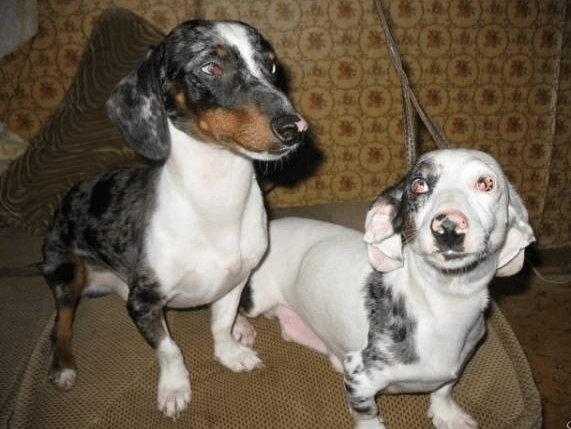
To clarify, not all double dapple puppies will suffer from these health issues. However, the rate of the occurrence of these problems is high enough for responsible breeders not to proceed with the breeding of double dapples.
On the other side, single dapple dachshunds are not affected by these lethal health problems.
Important note: For the reasons mentioned above, double dapple dachshunds are not permitted on the shows and this variety is considered “unacceptable” for breeding.
Diluted colours
Additionally, there are two d
Notably, dilute dachshunds can suffer from Colour Dilution Alopecia.
As a result, Kennel clubs frequently consider these
If you want to find out more about health issues, occurring in dachshunds, you can find the separate article here.
Dachshund sizes
Dachshund sizes are almost as diverse as dachshund colours.
You probably already know that a dachshund can range anything from the size of a cocker spaniel to the size of a chihuahua.
But in what sizes do dachshunds come in general?
Dachshunds come in two sizes: standard and miniature. The third size – rabbit ( from German –
Generally speaking, standard dachshund can weigh anywhere from 17 to 32 pounds ( 8-14kgs). There is no height standard for this type of Dachshund, however they are generally under 9 inches (23cm) in height.
Also, an ideal weight for a miniature dachshund is around 10 pounds (4.5kgs) and doesn’t usually exceed 11 pounds (5 kgs). The height of a miniature dachshund is usually 13-18 cm (5-7 inches) at the withers.
Important thing to remember that on the professional shows, dachshunds which appear thin and undernourished can be severely penalised.


